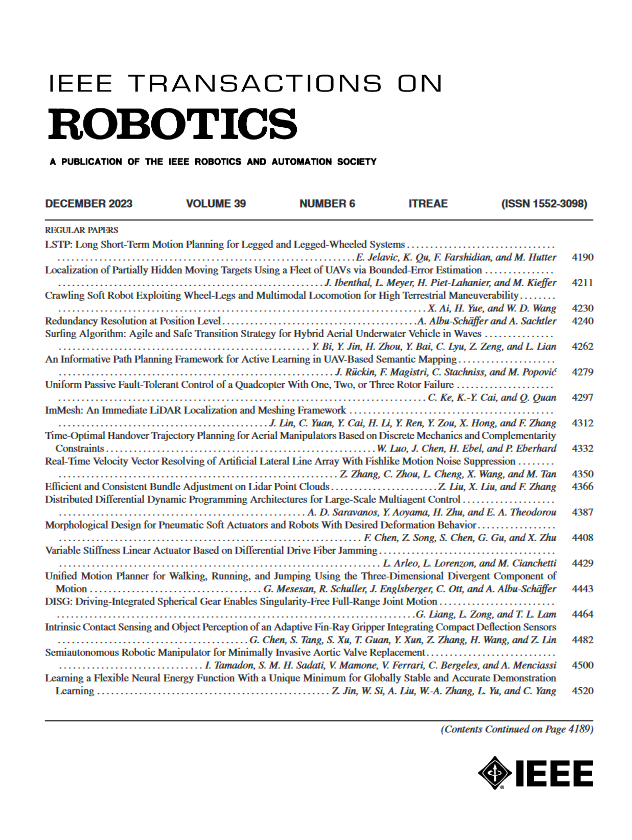通过长尾多视图采样整合单镜头视图规划与单次优视图
IF 10.5
1区 计算机科学
Q1 ROBOTICS
引用次数: 0
摘要
现有的视图规划系统要么采用次优视图(NBV)的迭代范式,要么采用基于集覆盖视图规划(SCVP)网络的一次性管道。然而,这两种方法都不能同时保证三维未知物体的高质量和高效率重建。为了解决这一挑战,我们引入了一个关键的假设:随着未知对象信息的可用性增加,SCVP网络的预测质量得到提高。有两种方法可以提供额外的信息:第一,利用从nvb获得的感知数据,第二,在扩展的多视图输入数据集上进行训练。在这项工作中,我们引入了一种新的组合管道,该管道在激活提议的多视图激活(MA-)SCVP网络之前包含单个NBV。MA-SCVP在我们的长尾采样方法生成的多视图数据集上进行训练,解决了多视图输入不平衡的问题,提高了网络性能。大量的模拟实验证实,与最先进的系统相比,我们的系统显示出显著的表面覆盖范围增加,移动成本大幅降低45%。现实世界的实验证明了我们的系统具有泛化和部署的能力。本文章由计算机程序翻译,如有差异,请以英文原文为准。
Integrating One-Shot View Planning With a Single Next-Best View via Long-Tail Multiview Sampling
Existing view planning systems either adopt an iterative paradigm using next-best views (NBV) or a one-shot pipeline relying on the set-covering view-planning (SCVP) network. However, neither of these methods can concurrently guarantee both high-quality and high-efficiency reconstruction of 3-D unknown objects. To tackle this challenge, we introduce a crucial hypothesis: with the availability of more information about the unknown object, the prediction quality of the SCVP network improves. There are two ways to provide extra information: first, leveraging perception data obtained from NBVs, and second, training on an expanded dataset of multiview inputs. In this work, we introduce a novel combined pipeline that incorporates a single NBV before activating the proposed multiview-activated (MA-)SCVP network. The MA-SCVP is trained on a multiview dataset generated by our long-tail sampling method, which addresses the issue of unbalanced multiview inputs and enhances the network performance. Extensive simulated experiments substantiate that our system demonstrates a significant surface coverage increase and a substantial 45% reduction in movement cost compared to state-of-the-art systems. Real-world experiments justify the capability of our system for generalization and deployment.
求助全文
通过发布文献求助,成功后即可免费获取论文全文。
去求助
来源期刊

IEEE Transactions on Robotics
工程技术-机器人学
CiteScore
14.90
自引率
5.10%
发文量
259
审稿时长
6.0 months
期刊介绍:
The IEEE Transactions on Robotics (T-RO) is dedicated to publishing fundamental papers covering all facets of robotics, drawing on interdisciplinary approaches from computer science, control systems, electrical engineering, mathematics, mechanical engineering, and beyond. From industrial applications to service and personal assistants, surgical operations to space, underwater, and remote exploration, robots and intelligent machines play pivotal roles across various domains, including entertainment, safety, search and rescue, military applications, agriculture, and intelligent vehicles.
Special emphasis is placed on intelligent machines and systems designed for unstructured environments, where a significant portion of the environment remains unknown and beyond direct sensing or control.
 求助内容:
求助内容: 应助结果提醒方式:
应助结果提醒方式:


